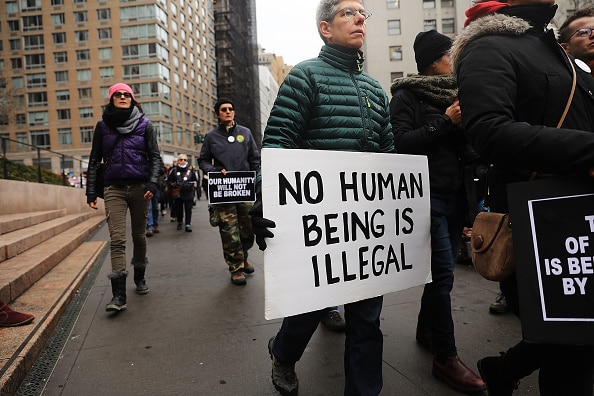Create a free profile to get unlimited access to exclusive videos, breaking news, sweepstakes, and more!
5 Facts About Immigration Bond That Will Make Your Blood Boil
Nefi Flores was released from immigration detainment with the help of a private company — that charged him $420 a month and required him to wear a GPS ankle monitor.

Nefi Flores fled gangs in El Salvador to go to America, where he lived as an undocumented worker. He eventually ended up in an immigration detention center in 2014 and was released thanks to a company called Libre by Nexus, which paid his bond, charged him $420 per month to retain their services for the duration of his case and forced him to wear a GPS ankle monitor — all via a contract he later said he was forced to sign in English, a language he didn’t understand. The Washington Post discovered his story mirrors countless others across the county.
In these times of inflated fear-mongering about immigrants of all sorts, it’s helpful to know something about immigration bail bonds, which remains a fast-growing for-profit industry in America. Start with these broad strokes:
1. An immigration bond doesn’t mean a criminal offense has occurred
Criminal bail bonds are paid to release someone who has committed a criminal offense from custody, but someone who is in custody by immigration hasn’t necessarily been given a criminal charge. According to guidelines posted to the Department of Homeland Security website, an immigration bond is “a guarantee to the government that, if you are let out of detention, you will go to all of your hearings and will obey the judge's order at the end of the case.”
2. Bonds have skyrocketed in the last 20 years
Immigration bonds have more than tripled in the past 20 years, which has caused spikes in incidences of immigrants choosing to self-deport or to remain in federal custody instead of facing fines. Bonds must either be paid in cash or as a “surety bond,” which is paid through an immigration bonds agent who charges 15-20 percent of the bond.
“Bonds vary anywhere from $10,000 to $25,000,” immigration bond agent Lorena Reyes told Desert Sun, which reported that the median fine jumped from $2,000 in 1996 to $8,000 in 2016. “Whereas before they’d be $3,000 or $5,000 and $10,000 was considered high.”
Individual cases have shown to be even higher. Gary Finn, a lawyer in Indio, CA, told Desert Sun that he knows of an immigration judge in Los Angeles who issues “astronomical” bonds and hit one of his clients who had once used a false name with a $100,000 bond.
3. Leniency isn’t a word used around here
You don’t get to mess around and miss your post-detention hearings, and get out of it — or get your bond money back.
“If you miss even one immigration hearing, you can be ordered removed (or ‘deported’) without the chance to give evidence to the judge or apply for permission to stay in the U.S.,” states the DHS website. “If that happens, you will not be allowed to return to the U.S. for at least 5 years, in some cases 20 years, and in some cases, forever!” Forever-ever?
4. Dealing with bond companies can be as frightening as being in custody
Mother Jones reported on the case of Sofia [last name withheld], who, similarly to Nefi Flores, had also left El Salvador for America as a teenager under threats from a drug cartel. She also ended up unwittingly contracted to Libre by Nexus and wearing a GPS ankle monitor which she and her mother said keeps them constantly worried and up at night.
“Sometimes we want to buy food to eat and we cannot because have to have the money ready to pay them,” they said. Others told the publication of GPS monitors that heated up to uncomfortable levels when charged or “bit” into their ankles.
5. There’s a mandate from Congress to keep a number of immigrants detained
Vice noted that there is a Congressional mandate called the “detention-bed mandate” to keep 34,000 immigrants detained “at any given time.” A source claimed that immigration bonds tend to soar when the detention center quotas are low, but the publication could not get Immigration and Customs Enforcement (ICE) to comment on the accusation. Hmm.
[Header Photo: A protest against President Donald Trump's immigration policies in front of the Federal Building on January 11, 2018 in New York City. Photo by Spencer Platt/Getty Images]














